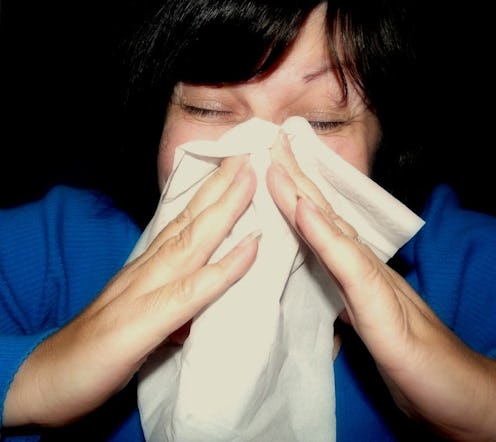
Thanksgiving through New Year’s tends to be one of the busiest times of the year for air travel — and unfortunately, this little tidbit isn’t going to make you feel much better about the insanity. This video shows you exactly how a sneeze spreads through an airplane cabin, and it’s just as horrifying as you think it is. Seriously, you guys. I’m not even that big of a germaphobe, but it’s making me never want to set foot on an airplane again. Can someone please just invent Star Trek-style transporters already?
Researchers at the FAA Center of Excellence at Perdue University wanted to take a look at how pathogens travel in airplane cabins. Accordingly, they used software from a company called ANSYS to create a simulation of a sneezing passenger — and the resulting vieo? Well… it’s not exactly pretty. Said ANSYS aerospace and defense industry director Robert Harwood to Popular Science, “The particles are colored to show you where the stuff goes. Those droplets get picked up by the airflow and get transported all over the cabin. They actually spread quite far.” It’s worth noting that Ebola isn’t an airborne pathogen, but you know what is? The flu. If you haven’t gotten your flu shot yet, now might be a good time to do it.
Scroll down to watch the whole video, but for the curious, here’s the general gist of it in seven pictures:
Step 1: Patient Zero
That’s your infected passenger right there. Say hello, everybody.
Step 2: Initial Sneeze
Like so many things, a sneeze starts so small…
Step 3: The Umbrella Effect
…But it quickly snowballs into something much bigger. First, the germs start to arch over the passengers on either side of Patient Zero…
Step 4: Side to Side
…Before reaching the passengers on the far edges of the aircraft.
Step 5: Circulation
From there, the particles actually move back towards the middle and up again…
Step 6: Spread and Dissipation
…Before spreading and finally dissipating.
Here’s a look at the passengers who are most at risk:
Sorry, guys. It all comes down to dumb luck, and you kind of lost the lottery.
It’s worth noting that the problem isn’t about “recirculated air”; as Robbie Gonzalez wrote at io9 a number of years ago, the whole “recirculated air” thing is a myth that’s been propagated so much over the years that it’s kind of running rampant now. But as we can see in the ANSYS simulation, the particles that emerge from a sneeze travel just fine on their own, so it’s still worth taking a few precautions. HuffPo has a bunch of tips geared towards keeping illness at bay while traveling; head on over there for the full list, but when in doubt:
- Don’t use the tray table;
- Stay away from the aisle seats;
- Hydrate often, and with hot water when possible;
- Try not to touch the toilet’s flusher, the lavatory door handle, or the overhead bins with bare skin;
- And wash your damn hands. None of that antibacterial gel stuff — actually wash them with soap and water.
Check out the full video below:
Images: mcfarlandmo/Flickr; ansysinc/YouTube (7)